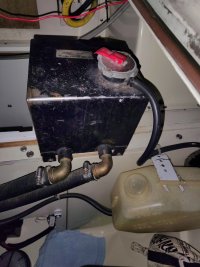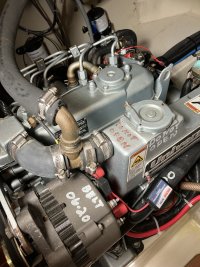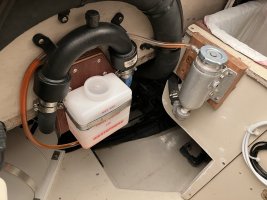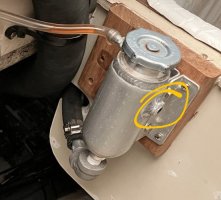Prairie Schooner
Jeff & Donna, E35-3 purchased 7/21
How to Flush Cooling System Without Starting Engine?
It's clear that salt water has been getting into the coolant circuit. A small leak could be the reason I could never keep fluid in the overflow tank. The overheat that precipitated this work might have enlarged a small preexisting leak between chambers of the exchanger. At the beginning of this season I cleaned the HX with Barnacle Buster and didn't notice anything, but could easily have missed a smaller version of it. It makes me think that a pressure check of the HX might be a good maintenance item every couple years.

At any rate, I'm going to do a thorough coolant circuit flush. My current plans are to use Barnacle Buster. Since I don't want to start the engine on the stands, I'm thinking of using a spare bilge pump in a bucket of BB to circulate the flush, with several repeats, maybe changing flow directions, described in the youtube below. Have any of you had luck with the pump technique? I'd take out the thermostat. Would I have to bypass the coolant pump somehow?
pump method
These are a few other references on flushing which make the most sense to me. There is some contradictory advice, Natch.
It's clear that salt water has been getting into the coolant circuit. A small leak could be the reason I could never keep fluid in the overflow tank. The overheat that precipitated this work might have enlarged a small preexisting leak between chambers of the exchanger. At the beginning of this season I cleaned the HX with Barnacle Buster and didn't notice anything, but could easily have missed a smaller version of it. It makes me think that a pressure check of the HX might be a good maintenance item every couple years.

At any rate, I'm going to do a thorough coolant circuit flush. My current plans are to use Barnacle Buster. Since I don't want to start the engine on the stands, I'm thinking of using a spare bilge pump in a bucket of BB to circulate the flush, with several repeats, maybe changing flow directions, described in the youtube below. Have any of you had luck with the pump technique? I'd take out the thermostat. Would I have to bypass the coolant pump somehow?
pump method
These are a few other references on flushing which make the most sense to me. There is some contradictory advice, Natch.
Flushing the coolant/antifreeze part of the cooling system. - Cruisers & Sailing Forums
Looking for a product or chemical to flush the coolant /antifreeze part of the cooling system on Kubota based engine , block, pump (aluminum), exhaust manifold and all. Most internet discussions
www.cruisersforum.com






